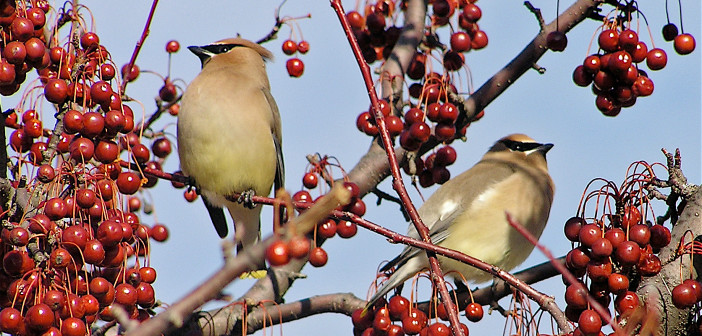Wildlife makes use of trees from the very top to the bottom. Alive or dead, standing or fallen, they’re places for nesting, resting, shelter, and food. It’s no wonder, then, that trees are valuable in a backyard wildlife habitat (and everywhere else). Native trees are best because they’re adapted to local environments and require less care.
The best time to plant a tree is twenty years ago. The second best time is now. — Chinese proverb
The food produced by a tree is called its mast. The mast of a walnut tree, for example, is walnuts, and that of a pear tree is pears. In addition to fruits and nuts, the mast of some trees is seeds, which are eaten by numerous species. Mast feeds animals in summer, fattens them up in the fall, and helps them survive through winter. The importance of mast to wild animals (and humans, too) can’t be overstated.
Hard-shelled mast
Nuts are a hard-shelled mast. They’re high in protein, carbohydrates, and fat. Nut-producing trees can be “messy” because fallen nuts litter the ground. But nuts are long-lasting and particularly valuable to squirrels, chipmunks, and other animals in the winter when other food sources are in short supply.
Soft mast
Trees that produce soft mast, like berries, provide moisture, sugar, carbohydrates, and vitamins to wildlife. Soft mast is fleshy and perishable. Some of these trees hold their fruit through the winter and become “last-resort” sources when almost everything else has been eaten. You can extend berry season by planting several different species that produce at different times. Soft mast trees draw large flocks of songbirds and other animals as their fruit ripens. Ground-feeding birds and other critters, including butterflies, will consume or sip juices from fallen, rotting fruit.
The trees listed here are proven to be valuable for nesting, resting, shelter, and their mast. Most are deciduous, meaning they drop their leaves in winter, but offer protection the rest of the year. Try to include some evergreens, such as pines, junipers or spruce, in your landscape, too—they provide year-round cover and mast in the form of seeds or berries.
SMALL NATIVE TREES
| SMALL NATIVE TREES | COMMON NAME | LATIN NAME |
|---|---|---|
| Alder | Speckled, Tag, Black | Alnus spp. |
| Beech | American | Fagus grandifolia |
| Blackhaw | aka Blackhaw Viburnum and Sweet Haw | Viburnum prunifolium |
| Blueberry | Highbush | Vaccinium corymbosum |
| Buckeye | Yellow, Western, Painted | Aesculus spp. |
| Cherry | Fire, Carolina Laurel, Chokecherry | Prunus spp. |
| Cranberry | Highbush | Viburnum trilobum |
| Desert Willow | Chilopsis linearis | |
| Dogwood | Flowering, Silky | Cornus spp. |
| Elderberry | American, Red | Sambucus canadensis |
| Fringe Tree | Chionanthus virginicus | |
| Hawthorn | Cockspur, Black, Downy, Washington | Crataegus spp. |
| Hazelnut | American | Corylus americana |
| Holly | Yaupon, Winterberry, Mountain | Ilex spp. |
| Mulberry | Red, White, Russian | Morus spp. |
| Oak | Blackjack, Post | Quercus spp. |
| Pawpaw | Asimina triloba | |
| Persimmon | Diospyros virginiana | |
| Plum | American, Mexican | Prunus spp. |
| Redbud | Eastern | Cercis canadensis |
| Serviceberry | Downy, Allegheny, Western | Amelanchier spp. |
| Sumac | Staghorn, Flameleaf, Smooth | Rhus spp. |
| Willow | Peach-leaved, Sandbar, Yellow | Salix spp. |
LARGE NATIVE TREES
| LARGE NATIVE TREES | COMMON NAME | LATIN NAME |
|---|---|---|
| Alder | Red | Alnus rubra |
| Ash | European, Green | Fraxinus spp. |
| Basswood | American, White | Tilia spp. |
| Beech | American | Fagus grandiflora |
| Birch | Paper, River, Yellow | Bettula spp. |
| Blackgum | aka Tupelo, Black Tupelo | Nyssa sylvatica |
| Boxelder | aka Boxelder Maple, Maple Ash | Acer negundo |
| Buckeye | Yellow, Red, Painted, Ohio | Aesculus spp. |
| Cherry | Wild Black | Prunus serotina |
| Hackberry | Northern | Celtis occidentalis |
| Hickory | Pignut, Shagbark, Mockernut, Bitternut | Carya spp. |
| Juniper (evergreen) | Eastern Red Cedar, Rocky Mountain | Juniperus spp. |
| Magnolia | Sweet Bay, Cucumber | Magnolia spp. |
| Maple | Red, Sugar, Mountain | Acer spp. |
| Mulberry | Red | Morus rubra |
| Oak | Bur, Chinkapin, Pin, English, Red. Willow | Quercus spp. |
| Pine (evergreen) | Shortleaf, White, Loblolly, Jack, Eastern White | Pincea spp. |
| Walnut | Black | Juglans nigra |
| Willow | Black, Yellow | Salix spp. |
Interactive USDA Plant Hardiness Zone Map For more information on specific trees, check out the Arbor Day Foundation. Add these special trees for wildlife






